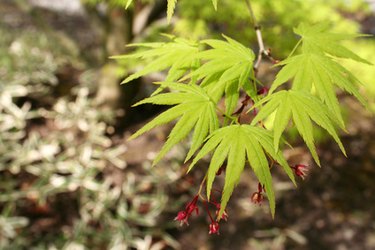
The rather slow-growing coral bark maple (Acer palmatum 'Sango-kaku') rarely requires pruning to develop an attractive and healthy branch structure and form. Maturing 15 to 25 feet tall and 12 to 20 feet wide, it gains its name from the striking coral-red to coral-rose coloring of its younger branches. This deciduous tree is best grown in USDA hardiness zones 6 through 8. While drought-tolerant once established, it's not overly resilient against winter cold or excessive summer heat, both of which can cause some twigs to die back. In cool summer regions provide full sun exposure, but in hot summer areas some shade in the hottest part of the summer afternoon improves the look and health of this tree.
Step 1
Wait to prune the coral bark maple until late fall or early winter. This improves your view of the tree's branching structure as well as avoids any sap bleeding that would occur if pruning was done in early spring, according to the Royal Horticultural Society.
Video of the Day
Step 2
Look for any dead, diseased or inward-crossing/rubbing branches in the tree's canopy. These branches warrant removal. Make the pruning cut 1/2-inch above the lower junction with a healthy branch with the hand pruners. Larger branches that are dead or sickly are best pruned away at their joint with the main trunk.
Step 3
Prune away any small twigs on the interior of the canopy near the central and lower parts of main branches. To prevent fungal disease issues, you want the interior of the maple tree (once its leaves appear next spring and summer) to be rather open and allow penetration of both light and air circulation. Make pruning cuts of these excessive twigs flush with the branch or trunk, but do not cut into, tear back or wound the bark integrity on these healthy branches and trunk.
Step 4
Examine the coral bark tree next spring to note if the winter weather caused any twig or limb die-back. Do not prune them now, but remember some clean-up trimming is needed. Once the leaves fully mature and it's early summer, return to trim out only the dead twigs from the last winter.
Tip
If any branches slated for pruning are larger than 3/4 inch in diameter, a loppers would cut the wood better than the smaller, thinner blades on the hand pruners.
Proper pruning to train a young coral bark maple's growth diminishes need for pruning later in life. For example, don't orient the tree at planting so that its branches naturally mature over a sidewalk or driveway that would mean pruning several years later. Or, remove the branch when it's small before it lengthens and reaches into an area you anticipate being problematic.
Warning
Overall, use restraint when pruning Japanese maple tree varieties. You don't want to prune away the naturally interesting tiered branching that gives the plant so much visual beauty and interest.
Video of the Day